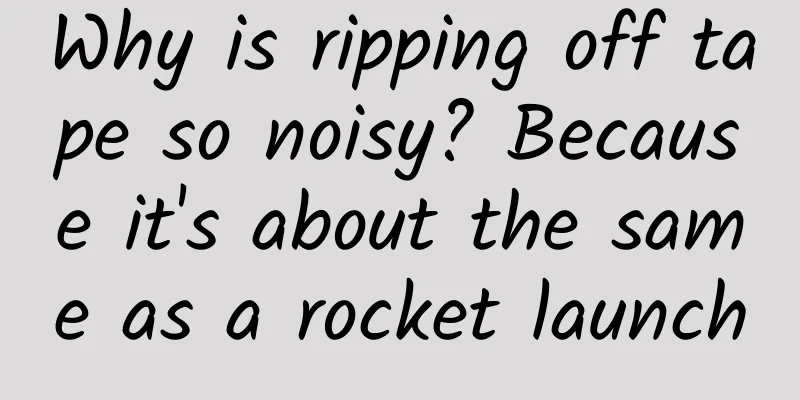Why is ripping off tape so noisy? Because it's about the same as a rocket launch

|
When we think of supersonic shock waves, we may subconsciously think of nuclear explosions, jet fighters, rocket launches, etc. These processes of instantaneous energy explosions are far from opening champagne, no matter how you look at it. But interestingly, according to "Champagneology" research, opening a bottle of champagne is very similar to a mini rocket launch, both of which produce supersonic shock waves. After a violent shake, we stare at the champagne bottle, expecting the cork to pop out in the next second. With a "pop", the wine and bubbles gushed out, and the crowd cheered - this is a common scene in celebrations. But this is not the correct way to open champagne, but it is quite dangerous, and people are injured every year. Let's start over, don't shake the champagne, remove the wire mesh covering the cork. Press the cork with one hand and slowly rotate the bottle with the other hand. The cork will naturally be pushed out by the air pressure inside the bottle, and then it will pop out with a "pop" sound, and then a light white mist will appear at the mouth of the bottle. Perhaps it was the white mist that caught people's attention. In an article published in Science Advances in 2019, physicists transformed themselves into "champagne scholars" and used a high-speed camera to record the moment when a champagne bottle was opened. They were surprised to find that after the cork popped out, the high-pressure airflow ejected from the bottle would actually form a supersonic shock wave. Supersonic shock waves are essentially the disturbance of the surrounding medium (such as air) when an object moves at supersonic speed, which continuously forms compressed airflow in front of the object. These compressed airflows carry huge energy and will impact the surrounding areas in the form of supersonic air waves. The upper right corner of the picture shows the shooting time: from 583 microseconds to 1000 microseconds. The high-speed camera captured that the Mach ring (the position indicated by the arrow) gradually moved away from the bottle mouth to the position of Figure E, and then completely dissipated in Figure F. (Image source: original paper) Mach ring Air flow is usually colorless, which means we cannot directly see the shock wave. So how can we capture the supersonic shock wave at the mouth of a champagne bottle with a camera? In fact, rather than saying that we saw a supersonic shock wave, it is better to say that we observed a phenomenon that can only be formed by supersonic air flow. When you look closely at these photos of champagne being opened, you'll notice a white line moving away from the mouth of the bottle until it disappears. If you look down from directly above the mouth of the bottle, you'll notice that this line is actually a ring - this is the Mach disk . A bright halo - the Mach ring - can be seen at the tail of my country's J-20 fighter. (Photo source: Xinhuanet) If you have ever paid attention to a supersonic aircraft taking off or a rocket launching, you may have noticed that there is always a string of bright halos at their tails, which are also Mach rings. Rockets and airplanes need to eject supersonic airflow to obtain powerful thrust. The pressure of the ejected supersonic airflow is very high, so when it is ejected from the nozzle into the atmosphere, it will expand directly; but the pressure of the expanded airflow will be lower than the atmospheric pressure, so it will be compressed again. In this way, the supersonic airflow will cycle back and forth between expansion and compression. This process will form expansion waves and compression waves. The two meet and overlap during the propagation process, forming a series of rings, which are Mach rings. It is not difficult to see the necessary conditions for the occurrence of the Mach ring phenomenon: first, supersonic airflow; second, the airflow pressure is not equal to the ambient pressure. The former meets the conditions for the occurrence of shock waves; while the latter can change the airflow and thus produce different waves. The Mach ring at the mouth of a champagne bottle is caused by the same reason as the Mach ring at the tail of a rocket, but there is a significant difference between the two: the temperature of the supersonic airflow . The moment the champagne cork pops out, the airflow in the bottle quickly overflows, causing the air pressure and temperature in the bottle to drop sharply, and the mixture of carbon dioxide and water vapor will condense into ice crystals, forming a gray-white mist. Therefore, the Mach ring at the mouth of a champagne bottle will appear in the white mist. The temperature of the airflow ejected by the rocket is too high, which will ignite the small amount of fuel mixed in it, making the Mach ring particularly dazzling. The moment the cork pops out However, although it is known that the airflow ejected from the mouth of a champagne bottle can exceed the speed of sound and produce Mach rings, the specific process and physical mechanism have not yet been clarified. This year, in an article published in the journal Physics of Fluids, scientists used computer simulations to further reveal the process of shock wave formation, evolution, and final dissipation in the 1 millisecond (1000 microseconds) when the champagne cork is popped. Champagne is rich in carbon dioxide, and the air pressure in the bottle is about 6 times the atmospheric pressure. The compressed carbon dioxide gas in the bottle will constantly exert an outward thrust on the cork, trying to push it out. Under stable conditions, the static friction between the cork and the bottle wall will balance the outward thrust. However, once you start to twist the cork, the static friction will quickly turn into dynamic friction and can no longer compete with the air pressure. The cork is now like a rocket, ready to go. Computer simulated image. From top to bottom, each row corresponds to the first stage, second stage, and third stage of the shock wave evolution. At 500 microseconds in the first row, the cork had just popped out, and the airflow could only expand laterally along the gap between the cork and the bottle mouth; at 917 microseconds in the second row, the cork was a certain distance away from the bottle mouth, and the airflow could be ejected directly, but it would collide with the cork to form a curved shock wave; at 1167 microseconds in the third row, the pressure difference between the inside and outside of the bottle decreased, and it was impossible to support the airflow to escape at supersonic speed. From left to right, each column shows the spatial distribution of flow velocity, air pressure, and temperature. Combining row and column variables, we can see the state of each stage and the interval distribution of different variables. (Image source: original paper) According to computer simulation, the changes in supersonic airflow in 1 millisecond after the cork popped out can be described in three stages: In the first stage of the cork popping out (within 600 microseconds), the carbon dioxide gas flow in the bottle will escape at supersonic speed, a process very similar to the air flow acceleration process of a rocket launch. The nozzle at the tail of the rocket is a funnel shape that is wide on both sides and narrow in the middle, also called a Laval nozzle. The ignited and heated high-pressure air flow will continue to compress and accelerate as it passes through the gradually narrowing front half of the nozzle. The narrowing shape of the bottleneck of the champagne bottle also has a similar effect, accelerating the air flow to supersonic speed at the bottle mouth. Just like a crowd of people moving slowly when stuck at a narrow intersection, but disperse and accelerate once they reach an open space, the airflow will also rush to expand and accelerate after being compressed through a narrow path and entering an open space. Therefore, the high-pressure airflow will achieve supersonic speed when it escapes from the bottle mouth and enters the relatively low-pressure external environment; while the rocket airflow can reach supersonic speed in the second half of the nozzle. Unlike a rocket, the cork at the mouth of a champagne bottle will hinder the direct ejection of the airflow because its movement speed is too slow compared to the airflow. At this stage, the supersonic airflow can only expand and escape laterally along the gap between the cork and the bottle mouth, forming a coronal shock wave, and the Mach ring phenomenon occurs at the same time. In the second stage when the cork leaves the bottle mouth (between 600 and 1000 microseconds), as the gas in the bottle continues to escape, it can finally be ejected straight out like a rocket airflow, and then it will collide with the cork slightly farther away, thus forming a curved shock wave. By the third stage (more than 1000 microseconds), the pressure inside the bottle gradually equals the atmospheric pressure, and the pressure difference at the bottle mouth cannot be maintained, and the airflow loses its power. Therefore, the jet airflow will continue to slow down until it is lower than the speed of sound, and the shock wave completely dissipates. Inspired by life This interesting research, which links rocket launches to the opening of champagne bottles, not only advances the study of "champagneology", but also provides references for a series of important applications, such as the ballistics of rocket and missile launches. This research can also help engineers who develop underwater vehicles and wind turbines to better understand fluid dynamics (the laws of motion of flowing materials under the action of forces). However, in fact, it is not only the opening of a bottle of champagne that produces supersonic shock waves. Have you ever noticed two very penetrating sounds in life: the "rip!" sound when peeling transparent tape, and the "crack! crack!" sound when cracking a whip in the park for exercise. If you tear the tape vigorously, you will find that the tape is always torn apart piece by piece, and you will hear a series of "tearing" sounds. When you forcefully tear the tape away from the attached surface, the tape adhesive will stretch like a spring and store elastic potential energy (so it cannot be torn off continuously). After the adhesive "spring" can no longer withstand the greater pulling force and breaks, the accumulated elastic potential energy will immediately be converted into kinetic energy at the split edge of the tape (the dividing line between the attached tape and the separated tape). If you use a high-speed camera to film this process, you will see that the split edge of the tape moves at a speed of 650 to 900 meters per second, far exceeding the speed of sound, even exceeding the speed of a fighter jet. This means that every time the adhesive tape accumulates potential energy and then peels off, it releases a tiny supersonic shock wave. So it is not difficult to understand that the superposition of mini sonic booms will certainly be harsh to our ears. When you tear off the transparent tape, you can’t avoid the harsh “tearing” sound (Image source: Pixabay) Some people may mistake the loud "crack! crack!" sound of whips in the park for the sound of whips hitting the ground, but in fact, these are all mini supersonic shock waves that explode in the air. When people whip vigorously, they transfer kinetic energy to the whip. Usually, the handle of the whip is thicker and has a larger mass. When the kinetic energy is transferred along the soft whip body to the thin and light whip tip, in order to ensure the conservation of momentum, the speed of the whip tip will be much greater than the speed of the handle, and it is easy to exceed the speed of sound, thus forming a local supersonic shock wave. This phenomenon, also known as the whiplash effect, comes from life, just like opening a bottle of champagne, but it also contains complex physical mechanisms. Now, if someone were to ask: What do champagne, tape, and whips have in common? Source: Bringing Science Home |
<<: The Earth we live on actually has a "dark history"?
>>: Can the unused electricity be stored?
Recommend
Common user incentive methods for event operations!
In the definition of a service platform, as the p...
Phoenix American: 2022 Commercial Real Estate Trends Report
Phoenix American released the "2022 Commerci...
3 key points to discuss the strategy of hot-selling products
There are a wide variety of products today, and t...
Internet Marketing Promotion Plan for Wedding Photography Industry
A sentence like " He said that any beauty th...
To get out of the traffic winter in 2019, operators must know two models
The more severe the economic environment, the mor...
Will having a fat belly make you stupid? Do these 6 things to effectively reduce belly fat!
Author: Xue Qingxin, registered dietitian Reviewe...
Hisense releases 120-inch full-color laser TV, creating a new track for China's giant screen technology
Against the backdrop of the normalization of the ...
In the next three to five years, China's home appliances industry will have two major opportunities.
In the next 3-5 years, China's home appliance...
These processes of Apple cannot be copied
[[123145]] "The last thing I want to say abo...
Mobile phone batteries usher in a breakthrough: charging in a few seconds can last for a week
Are you still worried about your phone running ou...
Drinking hot water from disposable paper cups will lead to the ingestion of a large amount of microplastics? Let's take a look at the research of Zhejiang University scientists
In daily life, Disposable paper cups are very con...
For an Internet finance platform, is a 30% increase in the number of users each month considered "growth"?
What is growth? Any growth that is not aimed at i...
8 trends in brand IP marketing in 2020
Looking back at 2019, various popular IP content ...
The emergency response level in 6 provinces has been lowered! Which six provinces are they? Has the epidemic reached a turning point?
At present, except for Hubei Province, the epidem...
4 strategies to improve user retention!
Improving user retention is a big topic. Next, we...









